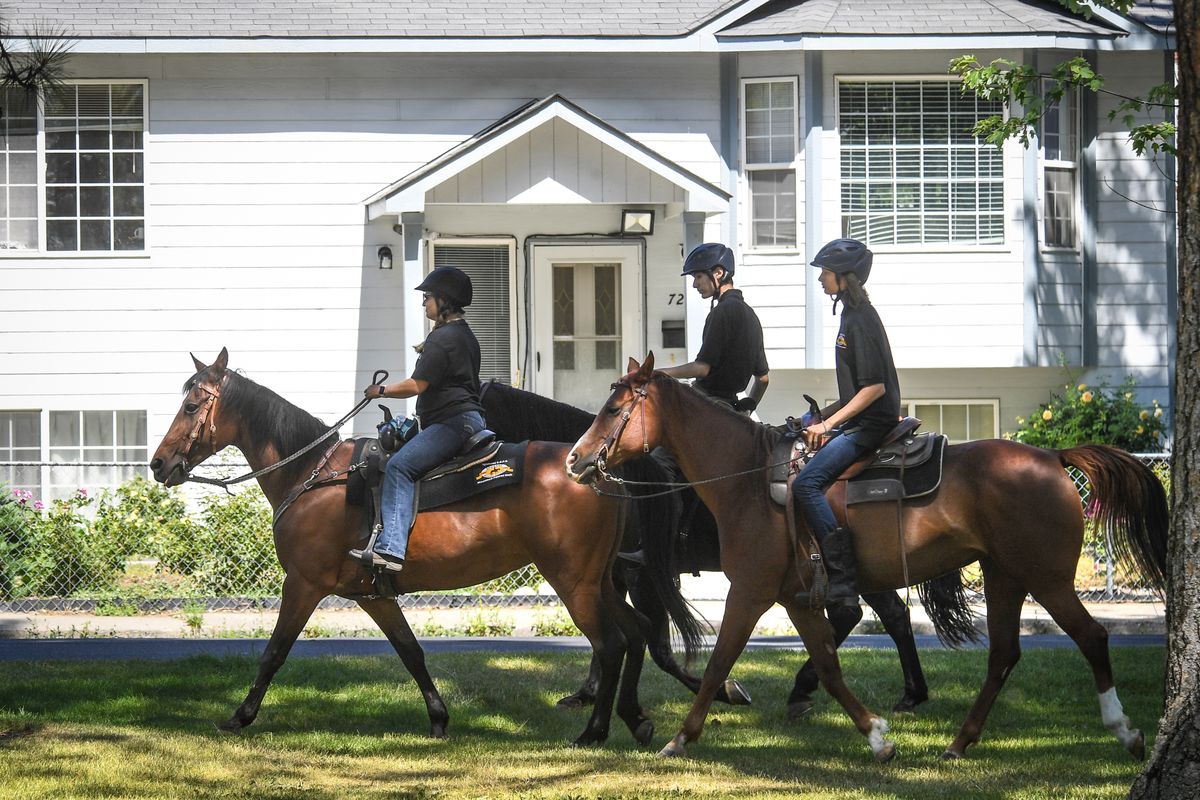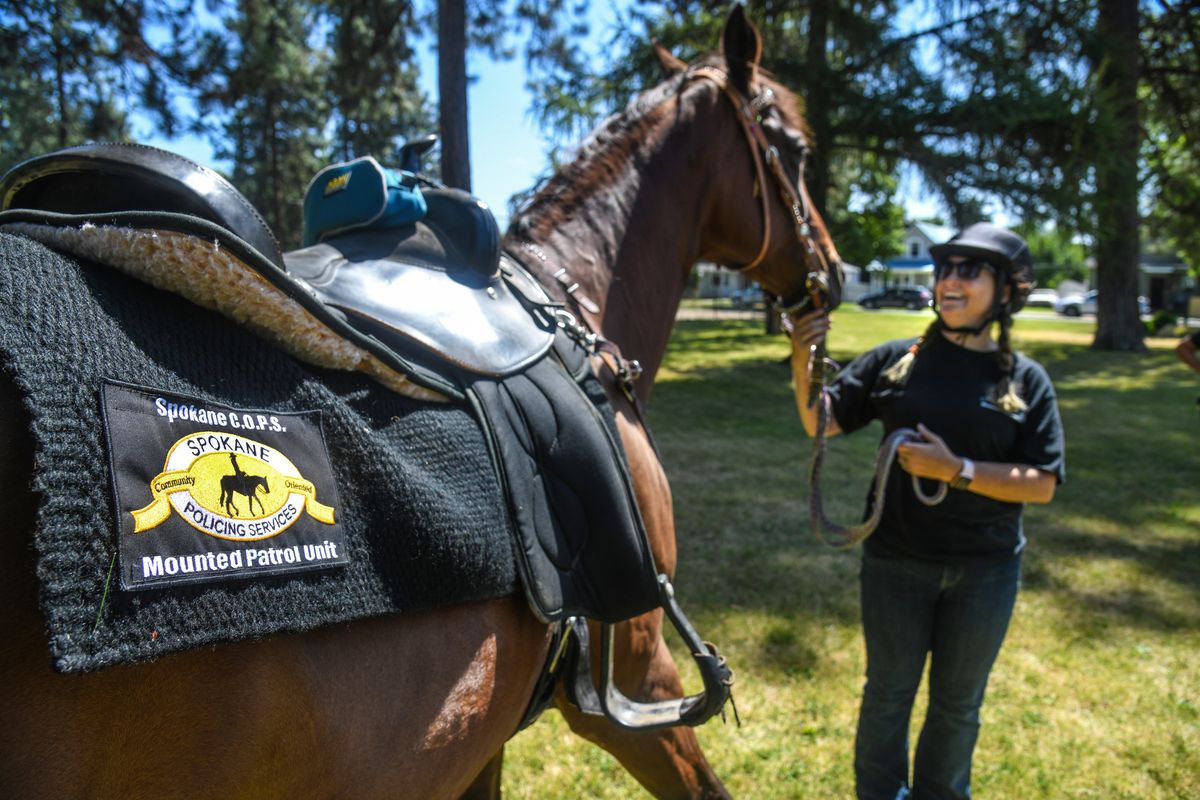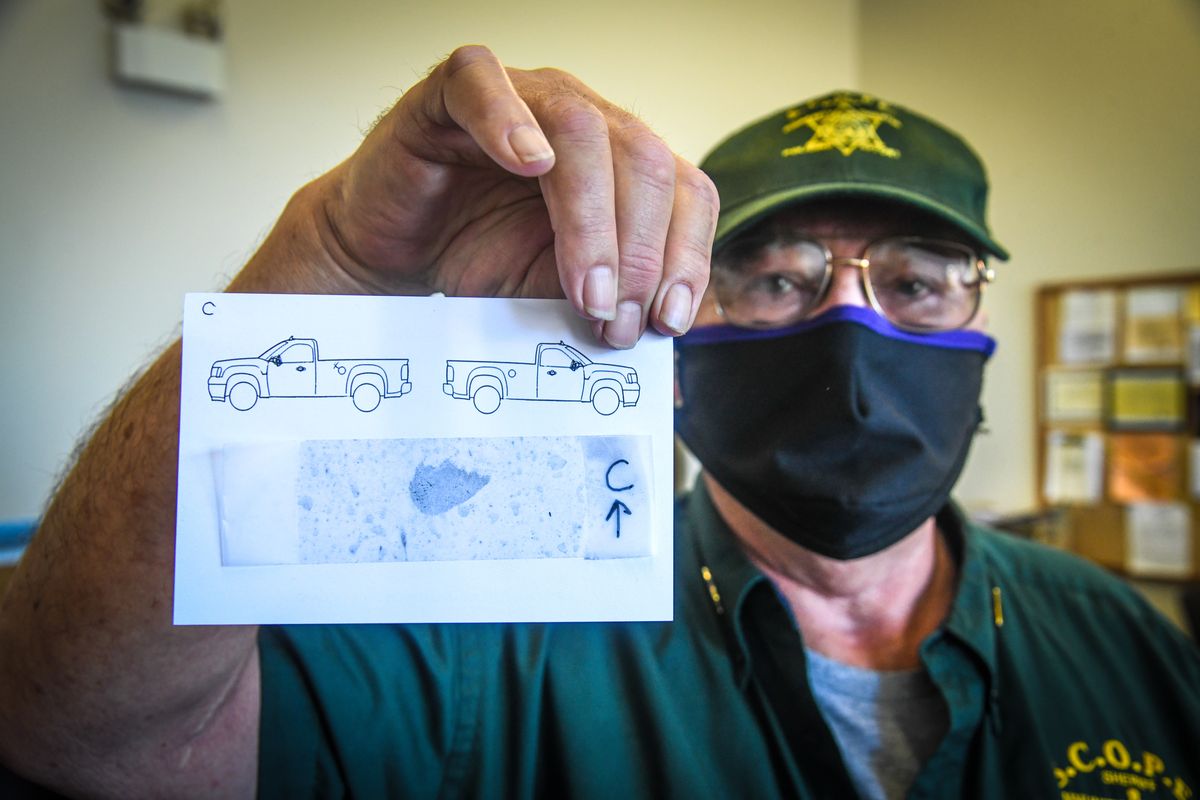Community-oriented policing has a long history in Spokane with two robust volunteer programs

Three horses ventured through Glass Park earlier this month, an odd sight in the north Spokane neighborhood.
Cars slowed as they passed by, couples came out of their homes and word spread quickly through the neighborhood, drawing children from blocks away to come pet the horses.
As part of Spokane Community Oriented Policing Services, or C.O.P.S., the mounted patrol draws families into Spokane parks in the hopes of pushing crime out and replacing it with community.
For Traci Ponto, a crime victim advocate at C.O.P.S. in the West Central neighborhood, bringing horses into the parks doesn’t just give kids, who may never have seen a horse before, a chance to interact with animals. It creates community connections.
“Most of these kids have never petted a horse, let alone seen one up close,” Ponto said.

They may not be able to afford to go to the fair or rodeo but this is free, Ponto added. As the kids pet the horses, Ponto shares why she’s there: to make the parks and neighborhoods safer.
“It has to be a community problem, which means we have to be hosting events in our city parks that draw families in,” Ponto said. “When you draw the families in, the criminal activity leaves.”
C.O.P.S. was founded in 1992 after two young girls were abducted in Spokane’s West Central neighborhood . One of the girls was found dead; the other has never been found.
West Central residents banded together to find a way to make their neighborhood and homes safer. Months later, the C.O.P.S. West location was created.
Now, decades later, there are 12 C.O.P.S. Shops, where volunteers gather to participate in more than 15 programs that focus on community building and safety. A neighborhood resource officer from the Spokane Police Department is also based at each shop. In some shops, Department of Corrections Community Corrections officers also utilize the space to see their parolees.
Patrick Striker, executive director of C.O.P.S., said he frequently hears people frustrated with police and community relations and sees the program as the answer to calls for community-oriented policing in Spokane.
“How do we get community and police officers to work well with each other and not see each other as the enemy?” Striker said. “I think in terms of trying to bridge that gap, people that get involved with us start seeing police officers as partners in safety as opposed to someone to be feared.”
As calls for police reform mount, with proposals suggesting shifting resources from armed officers to social workers and mental health professionals to let cops focus on crime, Striker said in many ways this is work that C.O.P.S. is already doing.
“The other part of it when you look at the defunding-of-the-police movement … people are saying, why are we using uniformed armed commissioned police for all of these things?” Striker said. “When you look at all these programs – here we’re talking to people in the parks, making it safer, but these are volunteers not commissioned, uniformed, gun-toting police officers.”
C.O.P.S. targets property crime through Neighborhood Observation Patrols, block watch groups, and Crime Prevention Through Environmental Design walk-throughs, among other activities.
Most homeowners will call Crime Check or 9-1-1 to report their car or garage being broken into but that is where the conversation stops, Striker said.
“There’s not that chance to say, what do I do now? How do I make sure this doesn’t happen again?” Striker said. “And that’s what the C.O.P.S. Shop is.”
A homeowner can file a report at the shop so the neighborhood resource officer will know about the issue, then a front desk volunteer will ask about their block watch, Striker said. If the area doesn’t have a block watch program, the volunteer can help set one up.
A trained volunteer can conduct a walk-through of the homeowner’s property to help with small changes to deter crime, Striker said.
“We want to get that mentality changed from, ‘How can someone else fix my problem? How can police fix this for me?’ to ‘What are the things myself and my neighbors can do?’” Striker said. “And there are so many things they can do that can really minimize that risk.”
Striker said the “backbone of crime prevention really is knowing your neighbors.”
That way, when burglars rent a moving van, pull up to your house, break down your door and start stealing your stuff, your neighbors will know something is wrong because they know you and know you are not moving.
“It’s so blatant what they’re doing but they get away with it because nobody talks to their neighbors,” Striker said. “When it comes to crime, there’s the crime itself and the damage that’s caused. Then there’s the fear of crime, and I think that the fear of crime is more debilitating than the crime itself.”
Part of pushing away that fear is “owning our spaces,” Striker said.
“I can’t tell you how many times we’ve shown up to a park, you can see there’s some sketchy stuff going on. We show up, people come out to see the horses, and one by one, all this sketchy stuff, they just leave somewhere else,” Striker said. “We were able to curb the bad stuff by just owning their space.”
After 15 years as a neighborhood resource officer in West Central and 25 years as a police officer, Ponto decided it was time to shift to community-oriented policing as a crime victim advocate, still in her beloved neighborhood.
“That neighborhood sucks you in, and they are the hardest workers, you just want to do it all for them,” Ponto said.
As a neighborhood resource officer, Ponto said she was “constantly pulled in different directions” following up on the most high priority calls, but by visiting a C.O.P.S. Shop victims can not only get closure but prevent themselves from becoming victims again.
In her new role, Ponto said, the resource she most frequently directs people to is 3-1-1, the city of Spokane’s customer service line. Ponto cited the broken window theory, that disheveled areas attract crime because criminals don’t think anybody cares.
“That criminal going by is not going to think anybody here cares, or pays attention, or is watching,” Ponto said.
Neighborhood Observation Patrols (NOPs) can be part of the solution by reporting problem properties quickly and keeping a visible patrol presence, Striker said.
Volunteer Doug McGuire has been “NOP’in,” as he calls it, for about four years. McGuire works out of C.O.P.S. Southwest on the west side of downtown. That office covers the majority of the South Hill.
McGuire hits problem areas and reports illegal camps but also does vacation checks for homeowners who are out of town.
“We have people who don’t know how to solve their own problems,” McGuire said of working front desk at the shop.
NOP patrols always have two people – one driver and one observer – McGuire explained.
He looks for graffiti, code violations, or potential stolen cars and reports anything he finds, McGuire said.
He also helps with the neighborhood’s speed radar sign. One afternoon last week, McGuire placed the sign on Lincoln Street in a high pedestrian area, hoping to slow speeding motorists.
The most notable thing about a NOP patrol, McGuire said, is the heads that turn as the repurposed police car passes. People stop what they’re doing and take notice, McGuire said.
The reports of problems like code violations that McGuire gathers are passed to the proper city department or added to the next graffiti clean-up list.
With all the volunteer opportunities and community building that C.O.P.S. offers, both Ponto and Striker said they’re frustrated by the general public’s lack of knowledge of the program, especially with community-oriented policing becoming a topic of national discussion.
“We’ve been doing community-oriented policing for 20 years, and I don’t think that folks understand that we’re already doing it. That we’re kind of leading the nation in that,” Ponto said. “You need to research your city and what great things your city is doing before you start throwing this out there that we don’t do this – we probably already do.”
In Spokane County, community-oriented policing has nearly as long a history as C.O.P.S.
The Sheriff Community Oriented Policing Effort, known as S.C.O.P.E., was founded in 1994 as a nonprofit volunteer organization to help with crime prevention and to facilitate community block watches. Since then the program has expanded to encompass close to 20 different programs, including Neighborhood Watch, School Patrols, Mounted Patrol, and Sheriff’s Office support programs like manning the front desk.
“Our mission is to help make our neighborhoods safer and work with law enforcement and the education part,” said Rick Scott, longtime S.C.O.P.E. director.
Currently the program has about 300 volunteers.
Lee Chessman, 80, is on his third career – though this time he’s technically a volunteer.
After serving in the Air Force as military police, Chessman sold insurance before moving to Nine Mile Falls to retire.
“I sat up there for about a year and I said I got to integrate with people again, I’m starting to lose it,” Chessman said.
A S.C.O.P.E. station had just opened in the area, so with his military experience, Chessman thought he would volunteer.

Eighteen years after he first decided to volunteer, Chessman is the coordinator for the S.C.O.P.E. Incident Response Team, which helps with traffic control at crime scene and other incidents.
“We have a two-part mission. The first mission is we support the Sheriff’s Department for traffic control,” Chessman said. “The other is to support community events.”
S.I.R.T. has vehicles that read “Sheriff” on the side and volunteers wear S.I.R.T. button-ups and hazard vests while on scene. The program always has at least two people on call.
The S.I.R.T. program contributes the most hours by far to S.C.O.P.E., with nearly 5,000 hours so far this year.
Shifting highly trained deputies’ time away from doing traffic control makes sense to Chessman.
“It makes sense to us, with deputies experienced in fighting crime, not to be directing traffic,” Chessman said.
In fact much of S.C.O.P.E.’s work helps shift deputies’ time to investigating crime, Scott said.
Volunteers staff the front desk at the Sheriff’s Office, help make copies, deliver mail and pick up surveillance footage from property crime scenes.
“All those little things like that, just getting videos, it takes up so much time from our detectives,” Scott said. “We can do things that are easy for us to do and gives them more time on what their experience, their expertise is.”
S.C.O.P.E.’s other focus is crime prevention through education, Scott said.
At each of S.C.O.P.E.’s 15 stations, volunteers provide information on home security, vehicle prowling and block watch programs. The stations are a place to chat with neighbors, but also report problems.
If someone is a snowbird or going on vacation, S.C.O.P.E. neighborhood patrols will watch their houses and check in when they return.
Volunteers offer information on vehicle prowling prevention and also help once a vehicle has been broken into. S.C.O.P.E. does latent fingerprinting in hopes of tracking car prowlers to multiple incidents, Scott said.
Earlier this month, Neil Sullivan was fingerprinting a truck that had been broken into . Sullivan, the president of the University S.C.OP.E. station, previously was a reserve deputy in King County for 15 years .
He has been doing latent fingerprinting for four years and said the process takes about an hour if they find prints. If the prints lead to an arrest, property crime detectives are sure to let the S.C.O.P.E. volunteers know their hard work is paying off, Scott said.
The S.C.O.P.E. program has an annual budget of $250,000, and is mainly funded by the Sheriff’s Office.
In 2019, volunteers provided over 65,000 hours of service, which Scott said equates to over $2 million in value.
“I always try to consider ourselves one of the best deals for the county,” Scott said.
Not all of S.C.O.P.E.’s value is quantifiable, though, Scott said. Volunteers are responsible for bringing the community together.
“The volunteers do live in the community, so maybe that’s where it ties them a little closer to their neighborhoods,” Scott said. “That communication amongst your neighborhood is huge because law enforcement may not know. They’re going to know about certain specific people, criminals, but they don’t know all the other stuff going on.”
Most of S.C.O.P.E.’s volunteers are retired, with 67% over the age of 65. Which means many of them are aging out or have put volunteering on hold during COVID-19, Scott said.
Brenda Davis has been volunteering for the past 23 years at the West Valley S.C.O.P.E. station. She was a fuel truck driver for 15 years and her husband, Richard Harmon Jr., was a semitruck driver.
“We’re both drivers at heart,” Davis said. “Citizens on patrol - that’s what we do in the car mostly.”
For Davis, joining S.C.O.P.E. was the perfect way to volunteer in her community, she said.
“I figured, well, I need to do something with the community, so it was either join the volunteer fire department or join S.C.O.P.E.,” Davis said with a laugh. “I didn’t think I would be a good fireman.”
Davis said she is frustrated that more people won’t join S.C.O.P.E. and create an environment of community in their neighborhood.
“I wish more people would stop whining and join,” Davis said. “We do need more volunteers. We’re all aging out.”
In 2013, S.C.O.P.E. had nearly 600 volunteers. Now there are about 300, Scott said. Despite putting in about 15 hours a week, Davis said she doesn’t feel like she’s changing lives, just steadily making a difference and meeting lots of “swell people” along the way.
“I don’t think I’ve done anything life-changing,” Davis said. “I think just accumulation, the neighbors wave back to you. They know who you are. Thank you for being in their neighborhood.”